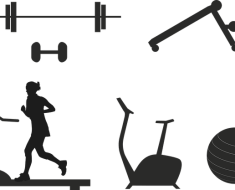A Healthy Diet
 It has been said that variety is the spice of life, and that is certainly true when trying to eat a healthy diet. No one likes to eat the same thing day after day, and boredom is the enemy of a healthy diet.
It has been said that variety is the spice of life, and that is certainly true when trying to eat a healthy diet. No one likes to eat the same thing day after day, and boredom is the enemy of a healthy diet.
Fortunately for those trying to follow a healthy diet, there is plenty of variety to be had in healthy foods. In addition to the hundreds of varieties of fruits and vegetables available at the average grocery store, there is a wide variety of beans, lentils, nuts, meat, dairy products, fish and poultry. There is no need for boredom to set in when pursuing a healthier lifestyle.’
The key to enjoying a variety of foods while eating healthy is to plan meals carefully and be sure to use the many varieties of foods that are available. Using a combination of fresh fruit, vegetables, meats and whole grains, it is possible to create a fresh, exciting and healthful meal every day of the week.
Nutritionists often stress the importance of a varied diet, both for nutritional and psychological reasons. A varied diet is essential for good health, since different types of foods contain different types of nutrients. And following a varied diet is important to your psychological well being as well, since feeling deprived of your favorite foods can lead you to give up your healthy lifestyle.
It is much better to continue eating the foods you like, but to eat them in moderation. Instead of giving up that juicy bacon, for instance, have it as an occasional treat, perhaps pairing it with an egg white omelet instead of a plateful of scrambled eggs. As with everything else in life, good nutrition is a trade off.
It is important for everyone to eat foods from the five major food groups each and every day. The five food groups identified by the USDA include grains, vegetables, fruits, milk and dairy and meat and beans. Each of these food groups contains specific nutrients, so it is important to eat a combination of these foods to ensure proper levels of nutrition.
Of course simply choosing foods from the five food groups is not enough. After all a meal from the five food groups could include cake, candied yams, avocados, ice cream and bacon. Although all five food groups are represented, no one would try to argue that this is a healthy day’s menu. Choosing the best foods from within each group, and eating the less healthy foods in moderation, is the best way to ensure a healthy and varied diet.
For instance, choosing healthy, lean meats is a great way to get the protein you need without consuming unnecessary fat and calories. And removing fat and skin from chicken is a great way to eliminate extra fat and calories.
When choosing breads and cereals, it is usually best to choose those that carry the whole grain designation. Whole grains, those that have not been overly refined, contain greater nutritional qualities and fewer sugars.
In addition, many grains and cereals are fortified with additional vitamins and minerals. While this vitamin fortification is important, it should be seen as a bonus, not as a substitute for a proper diet. Many foods are supplemented with important nutrients such as calcium (essential for strong bones and teeth) and folic acid (important in preventing birth defects).
Substituting healthier foods for less healthy ones is a cornerstone of a healthy diet. For instance, substituting lean cuts of meat for fattier ones, and substituting skinless chicken or turkey breast for less healthy drumsticks, is a great way to maximize nutrition without sacrificing good taste.
No matter what your reason for following a healthy diet, or what your ultimate fitness goals may be, you will find that a good understanding of nutrition will form the basis of your healthy diet. Understanding how the various food groups work together to form a healthy diet will go a long way toward helping you meet your ultimate fitness goals. Whether your goal is to run a marathon, lose ten pounds or just feel better, knowledge is power, and nutritional knowledge will power your diet for the rest of your life.






